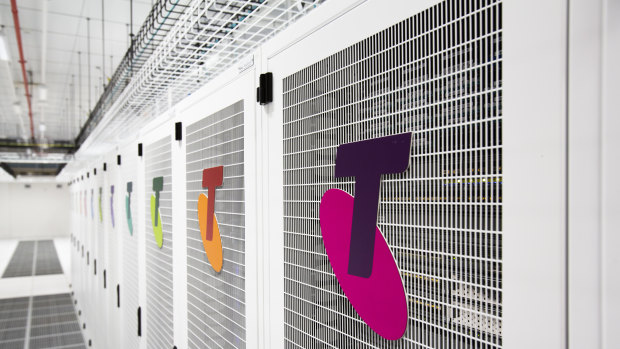This was published 4 years ago
Telstra plans to split into three units under radical restructure
Telstra has edged a step closer to making a play for the government-owned National Broadband Network after unveiling a three-way split that could see its valuable mobile towers put up for sale next year.
In the biggest corporate change since the government started privatising the company in 1997, Telstra's infrastructure business InfraCo will be divided into two separate units - InfraCo Fixed, which will own and run Telstra's fixed line assets, and InfraCo Towers, which will own its mobile infrastructure. A third unit, ServeCo, will own Telstra’s retail mobile business, including the back-end technology and spectrum.

It's the biggest corporate change since Telstra's privatisation, the company said.Credit: Craig Sillitoe
Telstra chief executive Andrew Penn said that carving InfraCo into two distinct businesses offered the telco more options, both in terms of potentially buying the NBN or selling off its infrastructure assets at an attractive price.
“This was always part of the plan, we set up InfraCo in 2018 to increase the transparency of our infrastructure assets and give us more optionality, I said at the time this was not going to be a trivial exercise and a massive amount of work needed to be done.”
“We have done a lot of that over the last two years, so we are at a natural point to take things to the next level.”
“I have always said that (InfraCo) was about having options when the NBN is privatised, and Telstra could not combine with the NBN in any way with the infrastructure and retail assets together, because the regulator (ACCC) and the government won’t allow it,” he added.
With the potential privatisation of the NBN unlikely to kick-off until 2024 at the earliest, finding a buyer for some of its mobile towers is a more pressing objective for Telstra.
Goldman Sachs has put a price tag of $4.5 billion on the mobile infrastructure and Mr Penn and Telstra’s chief financial officer Vicky Brady said prevailing market conditions were in Telstra’s favour.
“There is an enormous amount of interest in infrastructure assets at the moment,” they said.
“We have the biggest portfolio of towers, the strongest in the country and we think there will be strong interest,” Ms Brady said.
Telstra’s rival Optus is already hawking its mobile towers to buyers with a sale expected next year. Potential buyers of the $2 billion asset include private equity outfits like TPG Capital and Kohlberg Kravis Roberts, as well as specialist infrastructure operators like Axicom.
Having disappointed investors with its annual results in August, Telstra’s latest announcement was welcomed by the market, with Telstra shares closing three percent higher at $3.08, compared to a fall of 0.5 per cent for the broader market. The company’s stock is down 13 per cent for the year.
Sean Fenton, managing director at Sage Capital, said the proposed restructure should be good for Telstra.
“It’s a bit of a clean look through within the business of what the more valuable parts are..the prospect of potentially demerging some of the infrastructure assets and at some stage the possibility of NBN selling down or buying Telstra’s infrastructure, offers a pathway to unlocking value.”
“There is some confidence that the business is approaching the bottom of some of the structural pressures it is facing,” he said.
The proposed restructure is scheduled to be completed by December 2021. The three business units will operate under the parent company Telstra Group.
Mr Penn said the company was "very conscious of the many stakeholders, including shareholders, who will have an interest in these changes and that is why we have announced our intentions today, well ahead of implementation, so we can undertake a comprehensive consultation program to explain the many benefits this structure delivers.
“We will work very closely with our partners, our people and other stakeholders throughout this process, and will provide an update on progress at our half-year results in February 2021.”
Telstra on Thursday also re-confirmed its profit forecasts for financial year 2021, with underlying earnings expected to land at between $6.5 billion and $7 billion, and said it was confident it can lift earnings to a range of $7.5 billion to $8.5 billion by fiscal 2023.
Hitting the 2023 earnings target is critical to Telstra maintaining its dividend of 16 cents per share.
"If we are successful in getting into the bottom end of the $7.5 billion to $8.5 billion underlying EBITDA [earnings before interest, tax, depreciation and amortisation] range by FY23, this would equate to an estimated ROIC [return on invested capital] of close to 8 per cent,” Mr Penn said.
“As a result, we have updated our ROIC target accordingly to be around 8 per cent" by fiscal 2023, he said.
Business Briefing
Start the day with major stories, exclusive coverage and expert opinion from our leading business journalists delivered to your inbox. Sign up for the Herald's here and The Age's here.